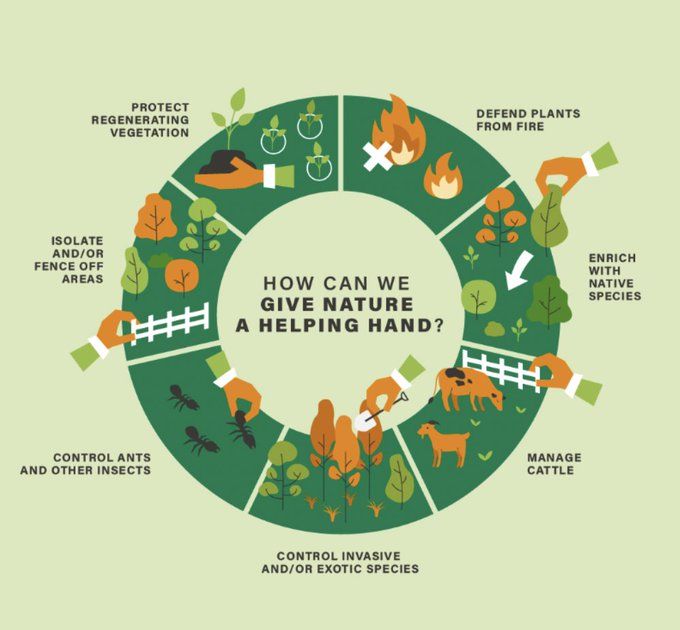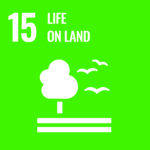ANR doesn’t work for every landscape and context. Hence, it is crucial to assess the local context and the applicability of the ANR method.
-
- ANR works best in areas that are not extensively degraded and remnants of forests and seeds in the soil are available (Source)
- The areas of consideration should not be heavily degraded by intensive farming and overgrazing.
- Adequate density of naturally regenerated seedlings. The minimum number of naturally regenerated seedlings required will vary based on their distribution, species composition, growth rates, soil fertility and rainfall. A general guide is that around 800 natural seedlings per hectare is required for ANR to be effective.
- Availability of seed inputs: ANR works best in areas that are not highly degraded but rather surrounded by forest patch remnants and where seeds are living in the soil.
- Competing land uses: The area should be not suitable for land uses that are economically more attractive. So ANR is usually practiced on land poorly suited for agriculture, hilly and rocky terrain, remote landscapes far away from roads and towns, marginal farmland where yields have declined for years, and areas that have not been plowed recently. The WRITER provides a flow diagram depicting whether ANR is a suitable restoration technique for a given landscape that can be assessed here.
- Social support: ANR has a lower cost as involves little preparation of the project site aside from eradicating threats or competition. However, upkeep of ANR tends to be labor intensive if implemented at a medium-to-high scale, in particular, needing regular maintenance to ensure competition and disturbances to seedlings from grasses. pests and weeds stay eliminated. Local communities need to be interested, willing and incentivized to participate in forest restoration.
- Capacity and local support: Local governments or civil society organizations should have the capacity and interest to provide personnel and funds for effective supervision.
- Law & Regulations: Should be a favorable policy and regulatory environment, as well as political will, for ANR restoration. Landowners may also need a fire permit to undertake firebreaks on the land or permission to do so, and these permits are issued only under a strict set of conditions. The PAFPA in South Africa outlined this on their website which can be accessed here.
Various different techniques and approaches exist under the umbrella terms of ANR. Nevertheless, some major subcategories could be used to summarize the rest. These are presented below, alongside some implementation practices.
Preliminary Stage - Conducting a site assessment
The preliminary assessment aims at determining the current state of the area of consideration and whether ANR is the most appropriate approach and if yes, what techniques should be applied. Some of the considerations that should be made are the following:
- What is the current state of the land? (e.g. healthy, semi-degraded, degraded, irreversibly degraded)
- Is there an availability of vegetation and seedings in the soil?
- What is the purpose/objective of the restoration practice?
1. Defending plants from fire - Creating Fire - breaks
Fire remains the most common cause of forest restoration failure. Most local forest authorities have inadequate resources and limited ability to suppress fires in remote areas, so local, community-based pre-prepared fire prevention initiatives, such as firebreaks, are often the most effective. Firebreaks is a larger-scale ANR technique which involves clearing strips of land of combustible vegetation to prevent the spread of wildfire. The most important materials to remove are grasses such as Imperata cylindrica that dry up during the hot season and easily catch fire. Firebreaks should be at least 6-8 m wide, but wider firebreaks and smaller block sizes are always better for reducing risk. Logically, firebreaks should be established prior to dry seasons.
A full guide on constructing and maintaining fire breaks can be found here.
2. Enrich with native species - Enrichment Planting
Enrichment planting, also known as in-fill or gap-planting, is a range of practices used to increase the density of desired tree species in secondary or degraded forests (Mangueira et al., 2019). Hence, enrichment planting presents a natural forest management tool which could be used as an active restoration technique. Some examples of enrichment planting are direct seeding (such as Muvuca), planting with cuttings and planting with potted seedlings.
A full guide on what enrichment planting is, how to implement it and what types of enrichment planting exist can be found here. (pp. 101-120)
3. Manage cattle
The livestock sector occupies around 30% of the land surface mainly through grazing and feed-crop production (Calle et al., 2012). As a result, the sector has turned into a leading driver of deforestation, land degradation, pollution, climate change, sedimentation of coastal areas and spreading of invasive species (Calle et al., 2012). Hence, applying various cattle management interventions is crucial for the future development of the industry and curbing of processes such as deforestation. Some examples of managing cattle interventions are silvopastoral systems, enclosing and grazing management.
For more on grazing interventions click here.
For more on integrating forestry, sustainable cattle-ranching and landscape restoration click here.
4. Control pests, invasive and exotic flora
‘Pressing’ or ‘lodging’ weeds is an example of suppressing floral competition that will reduce competition and the risk of fire. This technique is used instead of slashing them, which tends to stimulate faster grass regrowth and is done with a wooden board (approximately 15-30 cm wide and 1-1.2 m long). Attach a sturdy rope to both ends of the board. Lift the board onto the weed canopy and step on it with full body weight to fold over the stems of grasses and herbs near the base. Repeat this action, moving forward in short steps. Always press the weeds in the same direction. Pressing is best carried out when the weeds are about 1 m tall or taller as shorter plants tend to spring back up shortly after pressing.
5. Protect regenerating vegetation - Maintenance and protection
Weed pressing must be repeated at regular intervals until the regenerants close the canopy and naturally shade out the weeds. Maintenance should usually be carried out three to four times annually depending on the rainfall and weed growth rate. As a rough guide, if it looks like the weeds will overgrow the regenerants, carry out grass pressing. Firebreaks will also need to be maintained regularly, normally at least three times per year, with fire patrols by local residents carried out during the dry months.
6. Isolate and fence off areas
Land isolation or dancing off is usually a free-standing structure aimed at restricting or preventing movement across boundaries (Hayward & Graham, 2009). Conservation fences could include anything from standard posts and wire fences to sisal ropes covered with chili paste and live fences such as hedges (Heyward & Graham, 2009). To determine when and why to utilize fences for conservation it is crucial to understand well the processes which threaten the biodiversity in the area (Heyward & Graham, 2009).
For an extensive list of relevant threats, types and aims of fencing, species of conservation values, case studies on fencing and prospective costs click here.
Click here for a full guide/questionnaire of when ANR is the best guide to restoring degrading land
1. Projeto Cultivando Esperança in Paraná, Brazil (Isolate and Fence off Areas)
Description
As part of the Atlantic Forest Restoration Pact (PACTO), Projeto Cultivando Esperança is a project run by the NGO Mater Natura. Since its inauguration, the project aimed to assist in the regeneration of 265 hectares of forests around riverbanks. An ANR approach is being used to build fences to protect the growing trees and plant other specific plant species to enrich the local biodiversity. A feature of the project that made it successful was the economic benefits that accompanied the project development. Alongside the building of fences, the locals also grew yerba mate, which is a well-known plant for making tea and beverages, which created sustainable market opportunities for local communities. Additionally, 90 family farmers were trained in professional seedling and seed production, and sustainable use activities were implemented to generate income and engage families in maintaining the restored areas. The market opportunities incentivized the continuous implementation of ANR in the area. The project also encouraged compliance with environmental legislation, supported by various partners and funders, and facilitated discussions between landowners and environmental agencies on environmental adaptation and the importance of ecosystem services provided by riparian and preserved forests. Two planting techniques were used: traditional line planting of pioneer species interspersed with secondary and climax species at a density of 2,000 seedlings per hectare, and group planting in a "+" pattern with a density of 800 seedlings per hectare.
2. ANR project in Kandis, the Philippines (fire prevention, ring weeding of tree saplings and grass pressing)
Description
The Bagong Pagasa Foundation initiated an early ANR project in Kandis village, Puerto Princesa, Palawan Island, Philippines, to restore 250 hectares of degraded water catchment areas dominated by grasses. This project aimed to test ANR both as a forest restoration technique and as a tool for improving the livelihoods of 51 families by combining ANR with the establishment of fruit orchards. The treatments included fire prevention, ring weeding of tree saplings, and grass pressing. These methods facilitated the rapid growth of pioneer trees, which attracted seed-dispersing animals, promoting the recruitment of late-successional tree species. However, in areas where large seed-dispersing animals were absent, planting large-seeded forest tree species was necessary to recreate a biologically diverse forest ecosystem. The project demonstrated the flexibility of ANR, showing it could be combined with enrichment planting to meet specific restoration objectives or used to restore land fertility for agroforestry. After three years, a self-sustained forest ecosystem began to develop, with significant biodiversity recovery and soil improvement. The success of this project contributed to further promotion and funding of ANR practices by the FAO and the Philippine government, expanding ANR applications to other regions and countries.




